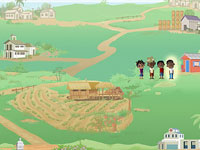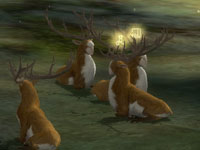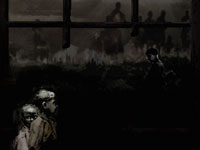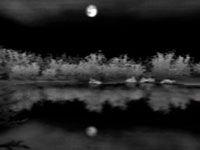Archive
About
Contact
Proposals
Blog
Play It! Make It!
Curated by Luke Munn >
-


Flow is being completely involved in an activity for its own sake. The ego falls away. Time flies. Every action, movement, and thought follows inevitably from the previous one, like playing jazz. Your whole being is involved, and you're using your skills to the utmost. (Mihaly Csikszentmihalyi)
Swimming sinuously through liquid, your avatar curls and glows, evolving slowly in layers of primordial soup. Based on pioneering research on the state of consciousness by Hungarian psychology professor Mihaly Csikszentmihalyi, Jenova Chen applies the idea to his own field: focusing the different facets of game design on one purpose: flow. Rather than complicated button combinations, creatures simply follow the mouse cursor. Forgoing lengthy explanations or backstories, Chen sets the player in the game immediately. Delving deeper and deeper below the surface, the gameplay itself is cyclical, consistent yet more and more challenging. And as one of it's greatest innovations, Chen takes the concept of Dynamic Difficulty Adjustment from thesis text to implementation: when a player is 'defeated' by an enemy, he floats up one level to an easier, less aggressive environment.
-


If playing Flow generates a harmonic state, Ayiti: The Cost of Life, produces a frustrating, hard-scrabble experience very suitable for it's subject. Named after the local Creole moniker for the Republic of Haiti, Ayiti places a poverty-stricken family in the hands of the player and lets them make decisions over 4 years. The tradeoffs are subtle and difficult. Work a higher paying job with more health risks, or something at minimum wage that's safer? Spend your yearly money on schooling, or buy books and attempt to self-educate? Home remedy or clinic? Bed or shoes? And just when players believe they're 'getting ahead', Hurricane Season comes around.
Part of Ayiti's provocation when released stems from it's 'winning formula' - actions, items, and strategies that lead to the good life. Unlike a fantasy shooter, Ayiti's grounding in real life circumstances and alignment with the UN meant that it was ideally situated to highlight code as controversy, logic as propoganda.
-


A work crossing the planes of fantasy and reality, The Endless Forest is a free-roaming online multiplayer project created by Auriea Harvey and Michael Samyn. Packaged as a screensaver, the work comes to life when your computer starts to sleep, recasting you as a stag in a dreamy, meditative forest setting, complete with ruins, ponds, and seasonal changes.
Without boundaries, goals, or levels, the interactive shifts the focus away from objectives and onto the stunning environment, which the team have obviously focused on. Light filters through pines, close objects obscure the player momentarily in a cinematic nod, and your avatar leaps across streams and into lavender glades.
In a strong move based on their interactive narrative backgrounds, the team have disabled any form of text or language communication. Avatars are 'named' with a randomly generated symbol. Communication with other stags takes the form of emotive actions - a bow, a cower, a prance. Language barriers are gone. So is specific communication ("walk to this location","how are you?"). But what Harvey and Samyn realised is that simple interactives require simple communication. Stags play "follow the leader", action their meaning through, or post general notices on a forum ("If I see you and don't respond, I'm sorry, my computer is playing up...").
-


[Vignettes] are frequently impressionistic and poetic, even if rendered in prose or visual form, a tendency reinforced by the term's secondary meaning in photography: a loss in clarity or brightness at the edge of an image due to the occlusion of a lens's circular optics on square or rectangular emulsion. (Ian Bogost)
From large worlds to small, Hush by Jamie Antonisse focuses in on two figures to create a tense, harrowing portrait. Designed as a game vignette, Hush borrows from the the literary or filmic concept of an "evocative description...of a person or situation" and translates it to video game form. And what a situation. Set in the horrific 1994 genocide of Rwandan's Hutu/Tootsi clash, the player's goal as mother is to calm her child into silence as rebel soldiers walk past the hut. Antonisse draws on one the genre's key strengths, the ability to create emotional states through the tiny, constant successes and failures of actual gameplay. The fear instilled by chilling propoganda sound clips mixed with soldier imagery fights with the need for the player to stay calm and collected in order to time lullabies correctly. The result is a very tangible tension that pays tribute, even in diluted form, to it's terrifing subject matter.
-


Based on the universal story of an individual mystic’s journey towards enlightenment, The Night Journey is an experimental game created by Bill Viola in collaboration with a team from USC's Interactive Division. Questioning if it's possible to "model such an intensely personal yet archetypal experience", this inquiry process yields results in various ways. The landscape of lakes and desert feels familiar but oddly alienating. The ambiguous 'between-time' of dusk is constant, unremitting, even iconic. Even the gameplay itself, while allowing personal wandering and exploration, comes back to a consistent set of visions witnessed by the player when reflecting. Dislocating and dreamlike, environments disappear and then vanish, blur into obscurity or disappear into darkness. Relinquishing the hard edged realism of traditional game aesthetics, the USC team instead desaturate and corrupt, resulting in a grainy landscape with "poetic presence" that integrates seamlessly with Viola's video pieces.
- Jenova Chen MFA Thesis: Flow in Games
http://jenovachen.com/flowingames/introduction.htm - Ayiti : The Cost of Life Walkthrough | Point and Click Games:
http://www.pointnclickgames.com/pointnclickgames/ayiti-the-cost-of-life/2/ - Ayiti: the Cost of Life: walkthrough, review, discussion, hints and tips at Jay is Games:
http://jayisgames.com/archives/2006/11/cost_of_life.php - Persuasive Games: Videogame Vignette, Ian Bogost
http://www.gamasutra.com/view/feature/3537/persuasive_games_videogame_.php?page=2 - Game Explores the High Cost of Living in Rural Poverty, Eleanor Lang
http://www.worldchanging.com/archives/007436.html